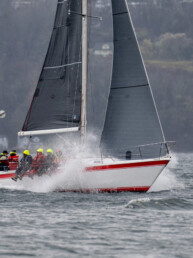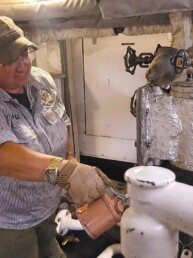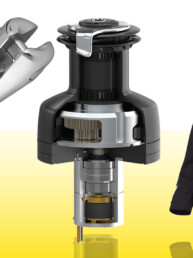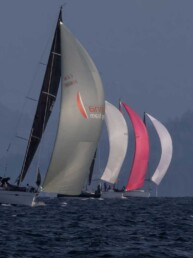Wouldn’t it be great if anchorages were always as serene as they look in cruisers’ pictures? Alas, that’s not a reality all of the time. Anyone who’s cruised on a sailboat for an extended period will eventually find themselves anchored in high wind or even storm conditions. Wicked weather is part of the cruising life.
Some storms are predicted well in advance, allowing sailors to change their voyaging plans or to seek shelter in a well-protected marina or anchorage. Other times, storms are a surprise. That’s exactly what happened to us on a trip to Liberty Bay, outside of Poulsbo, Washington.
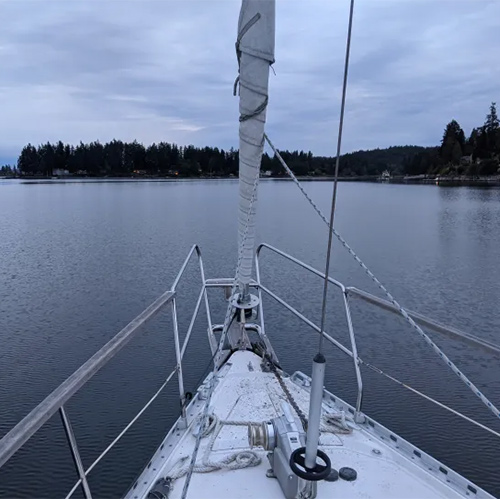
We first got word that bad weather was coming from a sweet couple paddling by our Nauticat 39, Polaris. Then we heard the news again the next day and confirmed it with updated weather reports. It was mid-September, the sky was blue, and the temperature was nearing 70 degrees. But the forecast called for winds up to 35+ knots out of the south near us the next day, and up to 50 knots in other areas of the Salish Sea.
We prepared Polaris for the impending wind and hunkered down below to watch the storm roll in. Flags near homes onshore whipped in the wind and dark gusts streaked across the normally placid Liberty Bay, turning it into a steely gray chop. In the distance, we watched other boats in the anchorage ride the same waves that were jostling our boat. My husband and I took turns going topside to check on the anchor chain and snubber, periodically adjusting it to prevent chafe. By bedtime, the wind had died off enough that Polaris was no longer spinning and surfing the waves, just rocking gently to lull me to sleep.
I’m happy to say that I have no drama to share from the event. No videos of boats dragging anchor or rocking and rolling. We rode out the storm just fine, and the experience made me think about what we did right and what we could do better in the future. Here’s what we did:
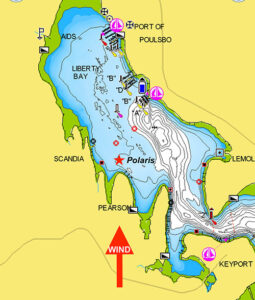
We made sure our equipment was up to the job. This step occurred long before we headed to Liberty Bay. Having the proper equipment to safely anchor in heavy wind and waves is of utmost importance. You need to have confidence in your ground tackle; the anchor, chain and/or rode, windlass, snubber, and deck cleats all need to be up to the task.
We use a 44-pound Lewmar Delta anchor on Polaris, which is considered to be oversized on Lewmar’s anchor size chart. We have 250 feet of 5/16-inch G4 chain and no nylon rode. We use a three-strand nylon line for our snubber and always use it after we drop the hook and are set. For the storm, we did make a few modifications from how we normally anchor.
We gave ourselves plenty of swing room. The biggest threat while anchoring in storm conditions is dragging. There are several ways to combat that, but the first is to take a look around your boat. How close are you to other boats? How close are you to other obstacles like rocks, shallow water, land, and docks?
Thankfully, there weren’t very many boats in the anchorage during this storm. Still, because Liberty Bay is such a big anchorage and connects to a long waterway that winds around Bainbridge Island, it gets a lot of fetch in certain wind directions. The resulting waves can lead to a pretty uncomfortable night on the hook. We opted to move Polaris so that we were upwind of all the other boats, and behind a headland so we were better protected from wind and waves.
We put out more chain than usual. The general rule for most cruisers is to put out a length of chain at least three or four times the depth where you are anchoring. We usually put out enough chain for a 5:1 scope; the only time we put out less is on a completely windless day in a crowded anchorage, like Port Blakely in the height of summer.
For the storm, we used about a 7:1 scope. The depth at high tide where we were anchoring was about 25 feet, so we put out about 175 feet of chain. The reason? If the wind picked up, there would be more room to stretch when the boat was blown back. Of course, chain doesn’t stretch, which is why…
We put out more snubber line. Having a snubber as part of your ground tackle setup is a must, especially when the wind kicks up. It’s also important for your snubber to be long enough to be let out when needed. For the snubber on Polaris, we attach it to the anchor chain using a rolling clove hitch with two half hitches, and then let out enough chain that the snubber line will take the initial load when the boat is pushed backwards.
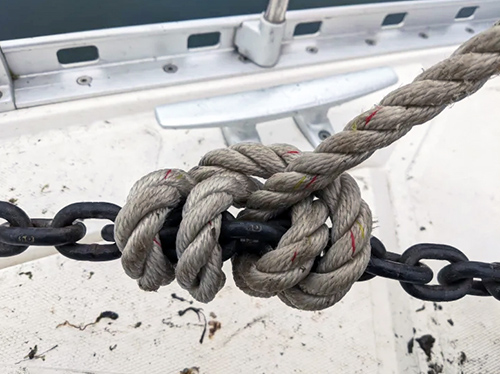
For the storm in Liberty Bay, we put out enough snubber line that the chain fell slack from the anchoring platform of the boat, and tied the boat end of the snubber to both the starboard and port bow cleats. We also backed down on the anchor at 2000 RPMs for several minutes to ensure the anchor was well set and that the snubber was taking the load, and that’s exactly what we saw.
Luckily, our snubber held up in the wind storm, but there are several weak points to any snubber. The biggest problem is chafe. All the pressure of the boat moving back and forth at anchor could chafe the snubber line to the point that it frays and even breaks. It’s prudent to consider adding a chafe sleeve or even a length of garden hose to protect the snubber in places where it is rubbing.
We’re happy with how we rode out this storm and know that there is a potential for nasty weather in the Pacific Northwest for almost 9 months of the year. Because we intend to cruise and anchor in the area for most of the year, we will definitely get the opportunity to test the strength of our anchoring system again. We’ve also learned to check the extended forecast before leaving the marina for a multi-day trip, and have made it a point to select anchorages that are oriented in such a way that we will be protected from the wind. A little extra planning goes a long way.
Tamara Miller and her husband, Charlie, live, work and cruise the Salish Sea on Polaris. Miller writes about her family’s experiences on and off the water at www.fouleduplife.com.

